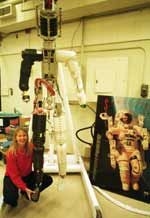Eliminating dead bugs on Mars-bound spacecraft, designing a skin-tight space suit and retrieving small objects that float away in space stations were some of the topics that came up during an international videoconference hosted by the MIT Mars Society on May 15.
"From Earth to Mars," which was videocast to MIT students in Rm 9-057 and to five French universities, included speakers Kenneth Jewett, a Jet Propulsion Lab/NASA engineer; Dava J. Newman, associate professor of aeronautics and astronautics at MIT; and Leopold Eyharts, a French astronaut who once spent several weeks on Mir, the Russian space station.
Some of the challenges in designing a vehicle for Mars's surface are the extreme temperatures and low surface pressure on the planet, said Mr. Jewett, who worked on the Pathfinder mission, the Shuttle Radar Topology Mission (SRTM) and the Mars 2001 Lander mission, which was to have been another small rover mission.
Mr. Jewett, who is building and testing a large prototype rover for a possible use on the 2007 Mars mission, pointed out that most electronics are tested to -40��� C., while Martian nighttime temperatures can drop to -80��� C. Surface pressure is equivalent to an Earth altitude of around 130,000 feet. And how do you navigate a vehicle from millions of miles away?
The 2003 Rover, a 150-kilogram machine with a robotic arm and 10-inch diameter wheels, will have stereo cameras and lasers that will reconstruct the objects in front of it. This will allow controllers to decide whether to drive over, around or through those objects. It will travel approximately 1 kilometer. The vehicle planned for 2007 may be as big as a car and travel "tens of kilometers," Mr. Jewett said.
"One of the really fascinating aspects of going to Mars is planetary protection," he said. "We are committed to not contaminate another world." To that end, he said engineers are dealing with the extremely difficult problem of how to ensure that there is no biological material on a spacecraft when it leaves Earth, including tiny spores. "There were a lot of dead bugs on the Pathfinder spacecraft," he said. They didn't cause any problems, but scientists will want to be sure that they when they comb a spacecraft returning from Mars for signs of life, they are not looking at ones that hopped a ride from Earth.
Engineers are toying with the idea of washing an entire spacecraft with a hydrogen peroxide plasma. Others are less worried with inadvertently creating interplanetary colonies of microscopic spores and more worried about life forms that the spacecraft might pick up on Mars. "How do you ensure not bringing back some evil microbe that will wipe out all life on Earth?" Mr. Jewett said.
A SUIT OF BIOSENSORS
Professor Newman, who is also a Harvard-MIT Health Sciences and Technology MacVicar Faculty Fellow, teaches space biomedical engineering. She talked about the challenges facing astronauts on human missions to Mars.
Astronauts on a mission lasting months could suffer from muscle atrophy as well as loss of muscle strength and 1-2 percent of bone density every month. "The job we have to do is make sure this doesn't happen," Professor Newman said.
She envisions a "skinsuit" or biosuit, as tight as those worn by Olympic athletes for speed-skating and other sports, filled with biosensors that would give NASA staff back on Earth a constant reading of the astronauts' vital signs. The suit would be mobile and lightweight, yet able to provide mechanical counterpressure to offset the lack of atmospheric pressure.
Ideally, the suit, with remote-controlled propulsion assistance, would even be able to help the astronauts walk as soon as they arrived on Mars. This would enable them to start to rehabilitate their partially atrophied muscles immediately.
LOST IN SPACE
Former fighter pilot and test pilot Eyharts, a colonel in the French air force, is a European Space Agency astronaut in training at the Johnson Space Center in Houston. From an astronaut's point of view, he said, the trip to Mars will be more demanding than a trip to the International Space Station because there is no reserve vehicle and less support from ground control to command and control the spaceship. If something goes wrong, "the crew is on its own to solve real-time problems," which may include in-flight maintenance of the ship itself.
While he was on Mir, Col. Eyharts found that a too-sudden or too-forceful movement in zero gravity could send you smashing into a wall. "You don't have to push too hard on your arms and legs to move," and it was difficult to get used to working "in a world where everything is floating," he said. He lost a lot of small pieces involved in the experiments he was performing, but the Russian crew members were able to recover them because they knew where the air currents within the space station tended to take free-floating objects.
Col. Eyharts said he believes humans will be better than robots at performing scientific experiments on Mars. "I don't think robots can perform scientific work in the same way humans can do it," he said.
In spite of the technical, physical and mental obstacles a trip to the red planet would entail, "I think ultimately humans will go to Mars simply because we want to do it," Mr. Jewett said.
The five French schools that participated in the videoconference are ������cole des Mines de Paris, ������cole Nationale Sup�rieure de M�canique et D'a�rotechnique, Sup�lec, ������cole Nationale Sup�rieure de l'A�ronautique et de l'Espace, and ������cole Centrale de Paris.
The MIT Mars Society is a chapter of the New England Mars Society. Its aims to further the goals of the human exploration and settlement of Mars through public and political outreach and education. It also undertakes technical projects and encourages the involvement of the MIT community.
A version of this article appeared in MIT Tech Talk on May 23, 2001.






